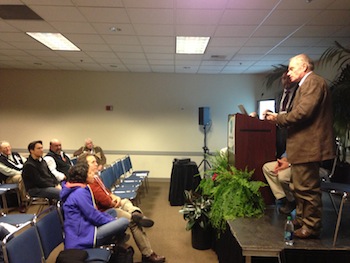The West Coast and East Coast may be apples and oranges when it comes to collaborative research, but which is the model for how it should be done?
“The West Coast has never not had the industry involved in cooperative research. You’ve always had good participation. You’ve got industry participation every level of the way,” said North Carolina skipper Jimmy Ruhle (right) during a session on cooperative research at the Pacific Marine Expo on Wednesday.
On the East Coast collaboration between scientists and fishermen has been a more recent development after years of the former not taking input from the latter seriously, he pointed out.
But the West Coast has room for improvement too, said John Gauvin, of the Alaska Seafood Cooperative. He looked at the level of NOAA involvement in various programs and found that it was more involved with the short-term ones, if involved at all. That kind of independence from NOAA could make it difficult for industry funded research to be implemented in fishery management decisions.
He believes a regional cooperative research program for Alaska — which doesn’t exist now — would provide an infrastructure for various efforts.
“Why wouldn't we want to have our own cooperative research program through NOAA like they do in New England?” he asked. “I really don't know if we’re the apples or the oranges.”
Research projects in the North Pacific run the gamut in size and scale, but what they all have in common is that NOAA manages the fisheries they study. Including NOAA in the collaborative process could make the information collected more valuable to Alaska's fisheries.







